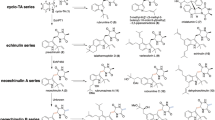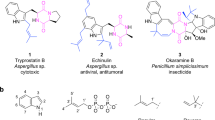Abstract
Cyclodipeptide synthases (CDPSs) comprise normally 200–300 amino acid residues and are mainly found in bacteria. They hijack aminoacyl-tRNAs from the ribosomal machinery for cyclodipeptide formation. In this study, nine new CDPS genes from eight Streptomyces strains were cloned into pET28a vector and expressed in Escherichia coli. Structural elucidation of the isolated products led to the identification of one cyclo-l-Trp-l-Leu, two cyclo-l-Trp-l-Pro, and three cyclo-l-Trp-l-Trp synthases. Other three CDPSs produce cyclo-l-Trp-l-Ala or cyclo-l-Trp-l-Tyr as the major cyclodipeptide. Total product yields of 46 to 211 mg/L E. coli culture were obtained. Our findings represent rare examples of CDPS family derived from actinobacteria that form various tryptophan-containing cyclodipeptides. Furthermore, this study highlights the potential of the microbial machinery for tryptophan-containing cyclodipeptide biosynthesis and provides valid experimental basis for further combination of these CDPS genes with other modification genes in synthetic biology.




Similar content being viewed by others
Change history
16 May 2018
The original version of this article contained mistake. After careful re-examination of the LC-MS data, the products of CDPSs “WP_031028810” and “BAU83478” should be cFL instead of cPY. We apologize for any inconvenience that this may have caused.
References
Alkhalaf LM, Ryan KS (2015) Biosynthetic manipulation of tryptophan in bacteria: pathways and mechanisms. Chem Biol 22:317–328
Borthwick AD (2012) 2,5-diketopiperazines: synthesis, reactions, medicinal chemistry, and bioactive natural products. Chem Rev 112:3641–3716
Brockmeyer K, Li S-M (2017) Mutations of residues in pocket P1 of a cyclodipeptide synthase strongly increase product formation. J Nat Prod 80:2917–2922
Chu D, Peng C, Ding B, Liu F, Zhang F, Lin H, Li Z (2011) Biological active metabolite cyclo (L-Trp-L-Phe) produced by South China Sea sponge Holoxea sp. associated fungus Aspergillus versicolor strain TS08. Bioprocess Biosyst Eng 34:223–229
Fan A, Winkelblech J, Li S-M (2015) Impacts and perspectives of prenyltransferases of the DMATS superfamily for use in biotechnology. Appl Microbiol Biotechnol 99:7399–7415
Giessen TW, Marahiel MA (2014) The tRNA-dependent biosynthesis of modified cyclic dipeptides. Int J Mol Sci 15:14610–14631
Giessen TW, von Tesmar AM, Marahiel MA (2013) A tRNA-dependent two-enzyme pathway for the generation of singly and doubly methylated ditryptophan 2,5-diketopiperazines. Biochemistry 52:4274–4283
Gondry M, Sauguet L, Belin P, Thai R, Amouroux R, Tellier C, Tuphile K, Jacquet M, Braud S, Courcon M, Masson C, Dubois S, Lautru S, Lecoq A, Hashimoto S, Genet R, Pernodet JL (2009) Cyclodipeptide synthases are a family of tRNA-dependent peptide bond-forming enzymes. Nat Chem Biol 5:414–420
Grundmann A, Li S-M (2005) Overproduction, purification and characterization of FtmPT1, a brevianamide F prenyltransferase from Aspergillus fumigatus. Microbiology 151:2199–2207
He F, Bao J, Zhang XY, Tu ZC, Shi YM, Qi SH (2013) Asperterrestide A, a cytotoxic cyclic tetrapeptide from the marine-derived fungus Aspergillus terreus SCSGAF0162. J Nat Prod 76:1182–1186
Huang R, Zhou X, Xu T, Yang X, Liu Y (2010) Diketopiperazines from marine organisms. Chem Biodivers 7:2809–2829
Jacques IB, Moutiez M, Witwinowski J, Darbon E, Martel C, Seguin J, Favry E, Thai R, Lecoq A, Dubois S, Pernodet JL, Gondry M, Belin P (2015) Analysis of 51 cyclodipeptide synthases reveals the basis for substrate specificity. Nat Chem Biol 11:721–727
James ED, Knuckley B, Alqahtani N, Porwal S, Ban J, Karty JA, Viswanathan R, Lane AL (2015) Two distinct cyclodipeptide synthases from a marine actinomycete catalyze biosynthesis of the same diketopiperazine natural product. ACS Synth Biol 5:547–553
Kieser T, Bibb MJ, Buttner MJ, Chater KF, Hopwood DA (2000) Practical Streptomyces genetics. John Innes Foundation, Norwich
Kumar SN, Mohandas C, Nambisan B (2014) Purification, structural elucidation and bioactivity of tryptophan containing diketopiperazines, from Comamonas testosteroni associated with a rhabditid entomopathogenic nematode against major human-pathogenic bacteria. Peptides 53:48–58
Li S-M (2010) Prenylated indole derivatives from fungi: structure diversity, biological activities, biosynthesis and chemoenzymatic synthesis. Nat Prod Rep 27:57–78
Lu C, Xie F, Shan C, Shen Y (2017) Two novel cyclic hexapeptides from the genetically engineered Actinosynnema pretiosum. Appl Microbiol Biotechnol 101:2273–2279
Maiya S, Grundmann A, Li S-M, Turner G (2006) The fumitremorgin gene cluster of Aspergillus fumigatus: identification of a gene encoding brevianamide F synthetase. Chembiochem 7:1062–1069
Moutiez M, Belin P, Gondry M (2017) Aminoacyl-tRNA-utilizing enzymes in natural product biosynthesis. Chem Rev 117:5578–5618
Moutiez M, Schmitt E, Seguin J, Thai R, Favry E, Belin P, Mechulam Y, Gondry M (2014a) Unravelling the mechanism of non-ribosomal peptide synthesis by cyclodipeptide synthases. Nat Commun 5:5141
Moutiez M, Seguin J, Fonvielle M, Belin P, Jacques IB, Favry E, Arthur M, Gondry M (2014b) Specificity determinants for the two tRNA substrates of the cyclodipeptide synthase AlbC from Streptomyces noursei. Nucleic Acids Res 42:7247–7258
Sambrook J, Russell DW (2001) Molecular cloning: a laboratory manual. Cold Spring Harbor Laboratory Press, Cold Spring Harbor, New York
Seguin J, Moutiez M, Li Y, Belin P, Lecoq A, Fonvielle M, Charbonnier JB, Pernodet JL, Gondry M (2011) Nonribosomal peptide synthesis in animals: the cyclodipeptide synthase of Nematostella. Chem Biol 18:1362–1368
Walsh CT (2014) Biological matching of chemical reactivity: pairing indole nucleophilicity with electrophilic isoprenoids. ACS Chem Biol 9:2718–2728
Walsh CT (2016) Insights into the chemical logic and enzymatic machinery of NRPS assembly lines. Nat Prod Rep 33:127–135
Winkelblech J, Fan A, Li S-M (2015) Prenyltransferases as key enzymes in primary and secondary metabolism. Appl Microbiol Biotechnol 99:7379–7397
Wohlgemuth V, Kindinger F, Xie X, Wang BG, Li S-M (2017) Two prenyltransferases govern a consecutive prenylation cascade in the biosynthesis of echinulin and neoechinulin. Org Lett 19:5928–5931
Xu W, Gavia DJ, Tang Y (2014) Biosynthesis of fungal indole alkaloids. Nat Prod Rep 31:1474–1487
Acknowledgements
We thank ARS Culture Collection (NRRL) for providing Streptomyces strains, S. Newel, and R. Kraut (University Marburg) for taking NMR and MS spectra.
Funding
The Bruker micrOTOF QIII mass spectrometer was financially supported in part by a grant from the Deutsche Forschungsgemeinschaft (INST 160/620-1 to S.-M. L.). J.L. and H.Y are scholarship recipients of China Scholarship Council (201608310118 and 201306220024).
Author information
Authors and Affiliations
Corresponding author
Ethics declarations
Conflict of interest
The authors declare that they have no conflict of interest.
Human and animal rights
This article does not contain any studies with human participants or animals performed by any of the authors.
Electronic supplementary material
ESM 1
(PDF 823 kb)
Rights and permissions
About this article
Cite this article
Liu, J., Yu, H. & Li, SM. Expanding tryptophan-containing cyclodipeptide synthase spectrum by identification of nine members from Streptomyces strains. Appl Microbiol Biotechnol 102, 4435–4444 (2018). https://doi.org/10.1007/s00253-018-8908-6
Received:
Accepted:
Published:
Issue Date:
DOI: https://doi.org/10.1007/s00253-018-8908-6




